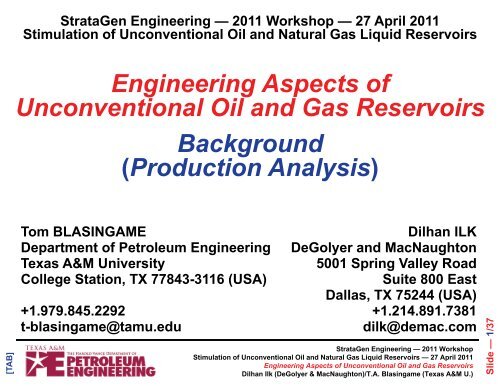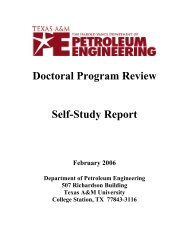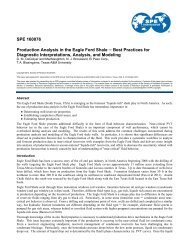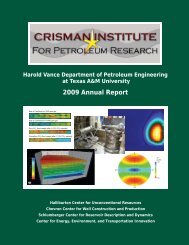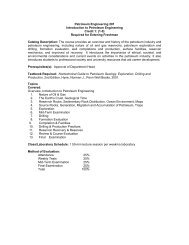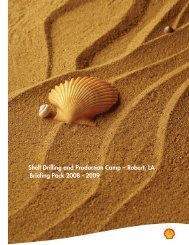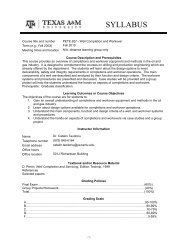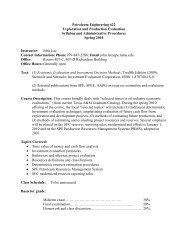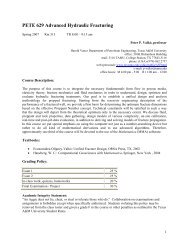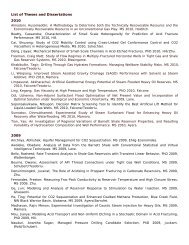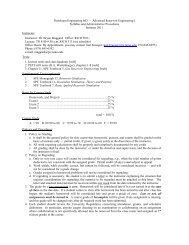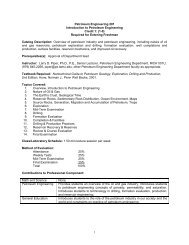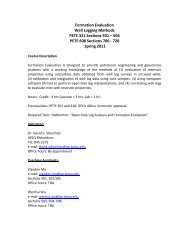Engineering Aspects of Unconventional Oil and Gas Reservoirs ...
Engineering Aspects of Unconventional Oil and Gas Reservoirs ...
Engineering Aspects of Unconventional Oil and Gas Reservoirs ...
Create successful ePaper yourself
Turn your PDF publications into a flip-book with our unique Google optimized e-Paper software.
StrataGen <strong>Engineering</strong> — 2011 Workshop — 27 April 2011<br />
Stimulation <strong>of</strong> <strong>Unconventional</strong> <strong>Oil</strong> <strong>and</strong> Natural <strong>Gas</strong> Liquid <strong>Reservoirs</strong><br />
<strong>Engineering</strong> <strong>Aspects</strong> <strong>of</strong><br />
<strong>Unconventional</strong> <strong>Oil</strong> <strong>and</strong> <strong>Gas</strong> <strong>Reservoirs</strong><br />
Background<br />
(Production Analysis)<br />
[TAB]<br />
Tom BLASINGAME<br />
Department <strong>of</strong> Petroleum <strong>Engineering</strong><br />
Texas A&M University<br />
College Station, TX 77843-3116 (USA)<br />
Dilhan ILK<br />
DeGolyer <strong>and</strong> MacNaughton<br />
5001 Spring Valley Road<br />
Suite 800 East<br />
Dallas, TX 75244 (USA)<br />
+1.979.845.2292 +1.214.891.7381<br />
t-blasingame@tamu.edu<br />
dilk@demac.com<br />
StrataGen <strong>Engineering</strong> — 2011 Workshop<br />
Stimulation <strong>of</strong> <strong>Unconventional</strong> <strong>Oil</strong> <strong>and</strong> Natural <strong>Gas</strong> Liquid <strong>Reservoirs</strong> — 27 April 2011<br />
<strong>Engineering</strong> <strong>Aspects</strong> <strong>of</strong> <strong>Unconventional</strong> <strong>Oil</strong> <strong>and</strong> <strong>Gas</strong> <strong>Reservoirs</strong><br />
Dilhan Ilk (DeGolyer & MacNaughton)/T.A. Blasingame (Texas A&M U.)<br />
Slide — 1/37
Starting Points: <strong>Engineering</strong> <strong>Aspects</strong> <strong>of</strong> UR<br />
●What we REALLY know…<br />
■ Tight <strong>Gas</strong> is Relatively Easy (Vertical Wells, HP/HT, PVT)<br />
■ <strong>Gas</strong> Shales are Technically Viable as a Resource (Economics?)<br />
■ We Can Consistency Deploy Horizontal Multi-Fracture Wells…<br />
●What we THINK know…<br />
■ The fracture geometry is…<br />
■ The phase behavior…<br />
■ The p tf to p wf conversion(s)<br />
●What we may NEVER know…<br />
■ Distribution <strong>of</strong> natural fractures…<br />
■ Transport mechanism for gas/liquids in shales<br />
(planar? complex?)<br />
(Can be extremely complex…)<br />
(what about the heavy water load?)<br />
●What we should know in the near future…<br />
■ Minimal/average duration <strong>of</strong> data required for EUR?<br />
■ Much better underst<strong>and</strong>ing <strong>of</strong> phase behavior.<br />
■ Optimal well spacing/orientation/placement.<br />
(impossible)<br />
(organic)<br />
[TAB]<br />
StrataGen <strong>Engineering</strong> — 2011 Workshop<br />
Stimulation <strong>of</strong> <strong>Unconventional</strong> <strong>Oil</strong> <strong>and</strong> Natural <strong>Gas</strong> Liquid <strong>Reservoirs</strong> — 27 April 2011<br />
<strong>Engineering</strong> <strong>Aspects</strong> <strong>of</strong> <strong>Unconventional</strong> <strong>Oil</strong> <strong>and</strong> <strong>Gas</strong> <strong>Reservoirs</strong><br />
Dilhan Ilk (DeGolyer & MacNaughton)/T.A. Blasingame (Texas A&M U.)<br />
Slide — 2/37
Overview: <strong>Engineering</strong> <strong>Aspects</strong> <strong>of</strong> UR<br />
●Where we are: (history lessons)<br />
■ Background<br />
■ Recent work<br />
●Where we want to be: (or so we think)<br />
(Historical Perspective)<br />
(Blasingame/team)<br />
■ Fit for purpose stimulation. (oil/gas/condensate/geology)<br />
■ More effective reservoir monitoring<br />
(this is important!)<br />
■ Early EUR<br />
(prediction/correlation)<br />
■ Well Spacing<br />
(geology + PVT + modeling)<br />
●How do we get there…<br />
■ Better underst<strong>and</strong>ing <strong>of</strong> flowback/dewatering (optimization)<br />
■ Pressure-dependent properties…<br />
(k, F cD , desorption?)<br />
■ Underst<strong>and</strong>ing <strong>of</strong> the pore-scale (what flows when/how)<br />
■ Petrophysics (conventional petrophysics not adequate)<br />
■ PVT<br />
(oil/gas/condensate/water — HP/HT)<br />
[TAB]<br />
StrataGen <strong>Engineering</strong> — 2011 Workshop<br />
Stimulation <strong>of</strong> <strong>Unconventional</strong> <strong>Oil</strong> <strong>and</strong> Natural <strong>Gas</strong> Liquid <strong>Reservoirs</strong> — 27 April 2011<br />
<strong>Engineering</strong> <strong>Aspects</strong> <strong>of</strong> <strong>Unconventional</strong> <strong>Oil</strong> <strong>and</strong> <strong>Gas</strong> <strong>Reservoirs</strong><br />
Dilhan Ilk (DeGolyer & MacNaughton)/T.A. Blasingame (Texas A&M U.)<br />
Slide — 3/37
Orientation: <strong>Engineering</strong> <strong>Aspects</strong> <strong>of</strong> UR<br />
●Is "shale gas" here to stay?<br />
■ We know where it is…<br />
■ We know how to get it (more/less…)<br />
■ We know how to produce it (sort <strong>of</strong>…)<br />
■ It all boils down to: Price/Timing/Technology<br />
●What could be "disruptive"<br />
■ Being able to deliver significantly more stimulation energy.<br />
■ "Green energy" initiatives (unlikely in the short term).<br />
■ Supply pressure on oil (this is more likely than we think).<br />
■ Environmental constraints (e.g., limiters to drilling/stimulation).<br />
[TAB]<br />
StrataGen <strong>Engineering</strong> — 2011 Workshop<br />
Stimulation <strong>of</strong> <strong>Unconventional</strong> <strong>Oil</strong> <strong>and</strong> Natural <strong>Gas</strong> Liquid <strong>Reservoirs</strong> — 27 April 2011<br />
<strong>Engineering</strong> <strong>Aspects</strong> <strong>of</strong> <strong>Unconventional</strong> <strong>Oil</strong> <strong>and</strong> <strong>Gas</strong> <strong>Reservoirs</strong><br />
Dilhan Ilk (DeGolyer & MacNaughton)/T.A. Blasingame (Texas A&M U.)<br />
Slide — 4/37
StrataGen <strong>Engineering</strong> — 2011 Workshop — 27 April 2011<br />
Stimulation <strong>of</strong> <strong>Unconventional</strong> <strong>Oil</strong> <strong>and</strong> Natural <strong>Gas</strong> Liquid <strong>Reservoirs</strong><br />
<strong>Engineering</strong> <strong>Aspects</strong> <strong>of</strong><br />
<strong>Unconventional</strong> <strong>Oil</strong> <strong>and</strong> <strong>Gas</strong> <strong>Reservoirs</strong><br />
Background<br />
(Production Analysis)<br />
[TAB]<br />
Tom BLASINGAME<br />
Department <strong>of</strong> Petroleum <strong>Engineering</strong><br />
Texas A&M University<br />
College Station, TX 77843-3116 (USA)<br />
Dilhan ILK<br />
DeGolyer <strong>and</strong> MacNaughton<br />
5001 Spring Valley Road<br />
Suite 800 East<br />
Dallas, TX 75244 (USA)<br />
+1.979.845.2292 +1.214.891.7381<br />
t-blasingame@tamu.edu<br />
dilk@demac.com<br />
StrataGen <strong>Engineering</strong> — 2011 Workshop<br />
Stimulation <strong>of</strong> <strong>Unconventional</strong> <strong>Oil</strong> <strong>and</strong> Natural <strong>Gas</strong> Liquid <strong>Reservoirs</strong> — 27 April 2011<br />
<strong>Engineering</strong> <strong>Aspects</strong> <strong>of</strong> <strong>Unconventional</strong> <strong>Oil</strong> <strong>and</strong> <strong>Gas</strong> <strong>Reservoirs</strong><br />
Dilhan Ilk (DeGolyer & MacNaughton)/T.A. Blasingame (Texas A&M U.)<br />
Slide — 5/37
Decline Analysis — Arps Relations: Base Relations<br />
Loss Ratio:<br />
1 qg<br />
<br />
D dq / dt<br />
Loss Ratio Derivative:<br />
b<br />
d<br />
<br />
dt<br />
g<br />
q<br />
<br />
<br />
dq<br />
<br />
<br />
q<br />
g<br />
<br />
q<br />
gi<br />
exp[ D t]<br />
g<br />
gi<br />
qg<br />
<br />
g / dt (1<br />
bD )<br />
(1/ b)<br />
<br />
it<br />
q<br />
i<br />
Trans., AIME (1945) 160, 228-247.<br />
Analysis <strong>of</strong> Decline Curves<br />
J.J. Arps<br />
Question(s):<br />
●How were the Arps' rate relations derived?<br />
The BASIS for the Arps' relations — i.e.,<br />
the behavior <strong>of</strong> the D- <strong>and</strong> b- parameters,<br />
is derived from OBSERVATIONS. These<br />
are empirical results.<br />
[TAB]<br />
Case Rate-Time Relation Cumulative-Time Relation<br />
qg<br />
qgiexp[ Dit]<br />
qgi<br />
Gp<br />
[1<br />
exp[ Dit]]<br />
D<br />
Exponential:(b=0)<br />
Hyperbolic: (0
Decline Analysis: EUR Plots (Arps' relations)<br />
Question(s):<br />
●Graphical extrapolations <strong>of</strong> EUR? Family <strong>of</strong> "EUR<br />
plots" derived from the Arps' exponential <strong>and</strong><br />
hyperbolic relations. Hyperbolic "EUR plot"<br />
requires a modular computing environment (e.g., a<br />
spreadsheet), as multiple variables are established<br />
simultaneously.<br />
SPE 98042 (2005)<br />
A Production-Based Method for Direct<br />
Estimation <strong>of</strong> <strong>Gas</strong>-in-Place <strong>and</strong> Reserves<br />
T.A. Blasingame, Texas A&M U. <strong>and</strong><br />
J.A. Rushing, Anadarko Petroleum.<br />
[TAB]<br />
Case<br />
Exponential:<br />
(b=0)<br />
qgi<br />
<br />
q g q gi D i G p G<br />
<br />
<br />
Di<br />
<br />
Hyperbolic: (0
Decline Analysis: Blasingame-Rushing EUR Plot<br />
Question(s):<br />
●Is there a distinctly unique mechanism for<br />
establishing the validity <strong>of</strong> the hyperbolic<br />
relation? Yes, the "hyperbolic" decline "type<br />
curve" plot yields straight-line trends.<br />
Gp<br />
qg<br />
qgi<br />
1<br />
<br />
G<br />
<br />
<br />
<br />
(1<br />
b)<br />
<br />
G<br />
<br />
<br />
qgi<br />
(1 b)<br />
Di<br />
<br />
<br />
<br />
SPE 98042 (2005)<br />
A Production-Based Method for Direct<br />
Estimation <strong>of</strong> <strong>Gas</strong>-in-Place <strong>and</strong> Reserves<br />
T.A. Blasingame, Texas A&M U. <strong>and</strong><br />
J.A. Rushing, Anadarko Petroleum.<br />
Hyperbolic Decline: (0
Decline Analysis: Fetkovich-Carter Type Curve<br />
JPT (June 1980) 1065-1077.<br />
Decline Curve Analysis Using Type Curves<br />
M.J. Fetkovich, Phillips Petroleum<br />
SPEJ (October 1985) 719-728.<br />
Type Curves for Finite Radial <strong>and</strong> Linear <strong>Gas</strong> Flow<br />
Systems: Constant Terminal Pressure Case<br />
R.D. Carter, Amoco Production<br />
[TAB]<br />
Variables for the Carter Decline Type Curve<br />
0.<br />
00633 kt<br />
1<br />
tDd<br />
<br />
gictir<br />
2 2 <br />
w 1 re<br />
re<br />
<br />
<br />
<br />
<br />
1<br />
<br />
<br />
1<br />
ln<br />
<br />
2 rw<br />
rwa<br />
<br />
<br />
2<br />
<br />
<br />
q(<br />
t)<br />
q<br />
s<br />
Dd <br />
rwa<br />
rwe<br />
<br />
kh ( pi<br />
pwf<br />
)<br />
r<br />
.<br />
e 1 <br />
141 2 giBgi<br />
ln<br />
<br />
<br />
rwa<br />
2<br />
a. Original format Fetkovich-Carter type curve — most important<br />
observation is that 01: transient flow or<br />
external drive energy.<br />
•: numerical gas flow<br />
solutions ( =f(p wf /(p i )).<br />
Reservoir Properties:<br />
•k — y-axis match.<br />
•G — x&y-axis matches.<br />
•s —r eD match.<br />
StrataGen <strong>Engineering</strong> — 2011 Workshop<br />
Stimulation <strong>of</strong> <strong>Unconventional</strong> <strong>Oil</strong> <strong>and</strong> Natural <strong>Gas</strong> Liquid <strong>Reservoirs</strong> — 27 April 2011<br />
<strong>Engineering</strong> <strong>Aspects</strong> <strong>of</strong> <strong>Unconventional</strong> <strong>Oil</strong> <strong>and</strong> <strong>Gas</strong> <strong>Reservoirs</strong><br />
Dilhan Ilk (DeGolyer & MacNaughton)/T.A. Blasingame (Texas A&M U.)<br />
Slide — 9/37
Decline Analysis: "Flowing Material Balance" Plot<br />
Question(s):<br />
●What is the "Flowing Material Balance" plot? In<br />
simple terms, p wf (t) data are "converted" to p avg (t)<br />
data using the pseudosteady-state flow equation,<br />
then plotted as a straight-line extrapolation function<br />
<strong>and</strong> "solved" for gas-in-place.<br />
JCPT (June 1997), 52-55.<br />
The 'Flowing' <strong>Gas</strong> Material Balance<br />
L. Mattar <strong>and</strong> R. McNeil, Fekete Associates<br />
"Flowing Material Balance" Plot:<br />
Theory:<br />
●Palacio <strong>and</strong> Blasingame [1993]<br />
●Mattar <strong>and</strong> McNeil [1997]<br />
●Agarwal et al [1999]<br />
[TAB]<br />
a. The "Flowing Material Balance" (Normalized Rate-Cumulative<br />
Function Plot) formulation is derived using the solution<br />
for the diffusivity equation during boundary-dominated flow<br />
regime. This formulation provides a direct estimate <strong>of</strong> the<br />
contacted gas-in-place using time, flowing wellbore pressure,<br />
<strong>and</strong> flowrate data.<br />
Advantages:<br />
●Straightforward <strong>and</strong> intuitive.<br />
●Shut-in pressures NOT required.<br />
●Direct estimation <strong>of</strong> contacted<br />
gas-in-place.<br />
Limitations:<br />
●Boundary-dominated flow<br />
regime must exist.<br />
StrataGen <strong>Engineering</strong> — 2011 Workshop<br />
Stimulation <strong>of</strong> <strong>Unconventional</strong> <strong>Oil</strong> <strong>and</strong> Natural <strong>Gas</strong> Liquid <strong>Reservoirs</strong> — 27 April 2011<br />
<strong>Engineering</strong> <strong>Aspects</strong> <strong>of</strong> <strong>Unconventional</strong> <strong>Oil</strong> <strong>and</strong> <strong>Gas</strong> <strong>Reservoirs</strong><br />
Dilhan Ilk (DeGolyer & MacNaughton)/T.A. Blasingame (Texas A&M U.)<br />
Slide — 10/37
Decline Analysis: Palacio Material Balance Time<br />
Question(s):<br />
●Can the well-reservoir model be inferred<br />
from such data? Yes.<br />
●Is diagnosis sufficient? No, we must also<br />
be able to model/history match data with<br />
a model (complete process).<br />
SPE 25909 (1993)<br />
Decline Curve Analysis Using Type Curves —<br />
Analysis <strong>of</strong> <strong>Gas</strong> Well Production Data<br />
J.C. Palacio <strong>and</strong> T. Blasingame, Texas A&M U.<br />
q<br />
g<br />
<br />
q<br />
gi<br />
(1 bD t)<br />
i<br />
( 1/ b)<br />
?<br />
Transient<br />
Flow<br />
m(<br />
p)<br />
<br />
Gp<br />
mˆ g,pss <br />
<br />
qg<br />
<br />
<br />
trans <br />
qg<br />
(1/4)<br />
<br />
<br />
<br />
Boundary-Dominated<br />
Flow<br />
m(<br />
p)<br />
<br />
Gp<br />
mˆ g,pss <br />
<br />
qg<br />
<br />
<br />
bdf <br />
qg<br />
(1)<br />
<br />
<br />
<br />
[TAB]<br />
a. Raw (daily) rate <strong>and</strong> pressure data — bottomhole<br />
pressures are calculated, note the effect <strong>of</strong> liquid<br />
loading.<br />
b. "Transformed" data shows fractured well<br />
response at early times, very strong evidence<br />
<strong>of</strong> closed system at late times.<br />
StrataGen <strong>Engineering</strong> — 2011 Workshop<br />
Stimulation <strong>of</strong> <strong>Unconventional</strong> <strong>Oil</strong> <strong>and</strong> Natural <strong>Gas</strong> Liquid <strong>Reservoirs</strong> — 27 April 2011<br />
<strong>Engineering</strong> <strong>Aspects</strong> <strong>of</strong> <strong>Unconventional</strong> <strong>Oil</strong> <strong>and</strong> <strong>Gas</strong> <strong>Reservoirs</strong><br />
Dilhan Ilk (DeGolyer & MacNaughton)/T.A. Blasingame (Texas A&M U.)<br />
Slide — 11/37
StrataGen <strong>Engineering</strong> — 2011 Workshop — 27 April 2011<br />
Stimulation <strong>of</strong> <strong>Unconventional</strong> <strong>Oil</strong> <strong>and</strong> Natural <strong>Gas</strong> Liquid <strong>Reservoirs</strong><br />
<strong>Engineering</strong> <strong>Aspects</strong> <strong>of</strong><br />
<strong>Unconventional</strong> <strong>Oil</strong> <strong>and</strong> <strong>Gas</strong> <strong>Reservoirs</strong><br />
Historical Work<br />
(Blasingame Team)<br />
[TAB]<br />
Tom BLASINGAME<br />
Department <strong>of</strong> Petroleum <strong>Engineering</strong><br />
Texas A&M University<br />
College Station, TX 77843-3116 (USA)<br />
Dilhan ILK<br />
DeGolyer <strong>and</strong> MacNaughton<br />
5001 Spring Valley Road<br />
Suite 800 East<br />
Dallas, TX 75244 (USA)<br />
+1.979.845.2292 +1.214.891.7381<br />
t-blasingame@tamu.edu<br />
dilk@demac.com<br />
StrataGen <strong>Engineering</strong> — 2011 Workshop<br />
Stimulation <strong>of</strong> <strong>Unconventional</strong> <strong>Oil</strong> <strong>and</strong> Natural <strong>Gas</strong> Liquid <strong>Reservoirs</strong> — 27 April 2011<br />
<strong>Engineering</strong> <strong>Aspects</strong> <strong>of</strong> <strong>Unconventional</strong> <strong>Oil</strong> <strong>and</strong> <strong>Gas</strong> <strong>Reservoirs</strong><br />
Dilhan Ilk (DeGolyer & MacNaughton)/T.A. Blasingame (Texas A&M U.)<br />
Slide — 12/37
Decline Analysis: Tight <strong>Gas</strong> Systems<br />
x<br />
X<br />
Pressure<br />
Monitoring<br />
Point No. 2<br />
SPE 109625 (2007)<br />
Estimating Reserves in Tight <strong>Gas</strong> S<strong>and</strong>s at HP/HT<br />
Reservoir Conditions: Use <strong>and</strong> Misuse <strong>of</strong> an Arps<br />
Decline Curve Methodology<br />
J.A. Rushing, A.D. Perego, R.B. Sullivan,<br />
Anadarko Petroleum, <strong>and</strong> T.A. Blasingame, Texas<br />
A&M U.<br />
y<br />
Wellbore<br />
Pressure<br />
Monitoring<br />
Point No. 1<br />
X<br />
Hydraulic<br />
Fracture<br />
[TAB]<br />
Numerical Model Considers:<br />
●Reservoir Layering.<br />
●k v /k h ratio.<br />
●Fracture Length, x f .<br />
●Fracture Conductivity, F cD .<br />
Analysis/Validation Approach:<br />
●Fit q(t) with Arps' hyperbolic relation.<br />
●Compare reserves to model at 30 years.<br />
StrataGen <strong>Engineering</strong> — 2011 Workshop<br />
Stimulation <strong>of</strong> <strong>Unconventional</strong> <strong>Oil</strong> <strong>and</strong> Natural <strong>Gas</strong> Liquid <strong>Reservoirs</strong> — 27 April 2011<br />
<strong>Engineering</strong> <strong>Aspects</strong> <strong>of</strong> <strong>Unconventional</strong> <strong>Oil</strong> <strong>and</strong> <strong>Gas</strong> <strong>Reservoirs</strong><br />
Dilhan Ilk (DeGolyer & MacNaughton)/T.A. Blasingame (Texas A&M U.)<br />
Slide — 13/37
Vertical TG/SG Wells: Elliptical Flow Domination<br />
SPE 106308 (2007)<br />
Evaluation <strong>of</strong> the Elliptical Flow Period for<br />
Hydraulically-Fractured Wells in Tight <strong>Gas</strong><br />
S<strong>and</strong>s — Theoretical <strong>Aspects</strong> <strong>and</strong> Practical<br />
Considerations<br />
S. Amini, D. Ilk, <strong>and</strong> T. A. Blasingame,<br />
SPE, Texas A&M U.<br />
a. Elliptical flow type curve solution — low fracture<br />
conductivity case.<br />
[TAB]<br />
b. Elliptical flow type curve solution — high fracture<br />
conductivity case.<br />
c. Elliptical boundary configurations (finite conductivity<br />
fracture case [Amini, et al (2007)].<br />
StrataGen <strong>Engineering</strong> — 2011 Workshop<br />
Stimulation <strong>of</strong> <strong>Unconventional</strong> <strong>Oil</strong> <strong>and</strong> Natural <strong>Gas</strong> Liquid <strong>Reservoirs</strong> — 27 April 2011<br />
<strong>Engineering</strong> <strong>Aspects</strong> <strong>of</strong> <strong>Unconventional</strong> <strong>Oil</strong> <strong>and</strong> <strong>Gas</strong> <strong>Reservoirs</strong><br />
Dilhan Ilk (DeGolyer & MacNaughton)/T.A. Blasingame (Texas A&M U.)<br />
Slide — 14/37
Horizontal TG/SG Wells: Compound Linear Flow<br />
Presented at the 2nd European Conference<br />
on the Mathematics <strong>of</strong> <strong>Oil</strong> Recovery,<br />
Cambridge, Engl<strong>and</strong> (1989).<br />
A Boundary Element Solution <strong>of</strong> the Transient<br />
Pressure Response <strong>of</strong> Multiply Fractured<br />
Horizontal Wells<br />
C.P.J.W. van Kruysdijk <strong>and</strong> G.M. Dullaert, Shell<br />
a. Rate performance behavior for a horizontal well with 4 transverse<br />
fractures — infinite-acting reservoir (analog to van<br />
Kruysdijk <strong>and</strong> Dullaert work). Fine-scale numerical model .<br />
[TAB]<br />
b. Specialized derivative plot (ref: van Kruysdijk <strong>and</strong> Dullaert) for<br />
a horizontal well with 4 transverse fractures — infinite- <strong>and</strong><br />
finite-acting reservoir cases. Fine-scale numerical model .<br />
c. Schematic diagram for the "compound linear flow"<br />
concept [van Kruysdijk <strong>and</strong> Dullaert (1989)].<br />
StrataGen <strong>Engineering</strong> — 2011 Workshop<br />
Stimulation <strong>of</strong> <strong>Unconventional</strong> <strong>Oil</strong> <strong>and</strong> Natural <strong>Gas</strong> Liquid <strong>Reservoirs</strong> — 27 April 2011<br />
<strong>Engineering</strong> <strong>Aspects</strong> <strong>of</strong> <strong>Unconventional</strong> <strong>Oil</strong> <strong>and</strong> <strong>Gas</strong> <strong>Reservoirs</strong><br />
Dilhan Ilk (DeGolyer & MacNaughton)/T.A. Blasingame (Texas A&M U.)<br />
Slide — 15/37
Low k Tight <strong>Gas</strong> S<strong>and</strong>s: Petrophysics/Permeability<br />
<strong>Gas</strong> Flow<br />
v y<br />
v x<br />
SPE 107954<br />
Improved Permeability-Prediction Relations<br />
for in Low Permeability S<strong>and</strong>s<br />
F.A. Florence, Occidental Petroleum Corp.,<br />
J.A. Rushing, Anadarko Petroleum Corp., K.E.<br />
Newsham, Apache Corp., <strong>and</strong> T.A.<br />
Blasingame, Texas A&M U.<br />
a. <strong>Gas</strong> Slippage — Kundt, A. <strong>and</strong> Warburg, E.: "Über Reibung<br />
und Wärmeleitung verdünnter <strong>Gas</strong>e, " Poggendorfs Annalen<br />
der Physik und Che-mie (1875), 155, 337.<br />
[TAB]<br />
b. Knudsen "micr<strong>of</strong>low" model (Modified from Karniadakis <strong>and</strong><br />
Beskok, 2002).<br />
k<br />
k<br />
a<br />
<br />
<br />
128<br />
1<br />
<br />
<br />
2<br />
15<br />
<br />
<br />
-1 <br />
tan 4a0<br />
<br />
<br />
1<br />
k<br />
p<br />
m<br />
0.4<br />
a <br />
1 a2<br />
<br />
a1<br />
a2<br />
<br />
<br />
<br />
<br />
1<br />
<br />
11/<br />
a<br />
<br />
<br />
c. Micr<strong>of</strong>low model <strong>and</strong> correlation, "fully implicit" formulation.<br />
StrataGen <strong>Engineering</strong> — 2011 Workshop<br />
Stimulation <strong>of</strong> <strong>Unconventional</strong> <strong>Oil</strong> <strong>and</strong> Natural <strong>Gas</strong> Liquid <strong>Reservoirs</strong> — 27 April 2011<br />
<strong>Engineering</strong> <strong>Aspects</strong> <strong>of</strong> <strong>Unconventional</strong> <strong>Oil</strong> <strong>and</strong> <strong>Gas</strong> <strong>Reservoirs</strong><br />
Dilhan Ilk (DeGolyer & MacNaughton)/T.A. Blasingame (Texas A&M U.)<br />
<br />
<br />
<br />
a<br />
<br />
<br />
0<br />
1<br />
k<br />
p<br />
m<br />
<br />
<br />
<br />
<br />
<br />
<br />
0<br />
4<br />
1<br />
k<br />
p<br />
m<br />
a1<br />
a2<br />
<br />
<br />
<br />
<br />
<br />
<br />
<br />
Slide — 16/37
Low k <strong>Reservoirs</strong>: Characteristic Behavior<br />
SPE 114168<br />
The Characteristic Flow Behavior <strong>of</strong> Low-<br />
Permeability Reservoir Systems<br />
T.A. Blasingame, Texas A&M U.<br />
A<br />
B<br />
a. Systematic "mapping" <strong>of</strong> the inter-relation <strong>of</strong> petro-physical<br />
properties. Note that Archie observed that permeability was<br />
"connected" to saturation, porosity, <strong>and</strong> electrical properties<br />
— but the relationship was vague, as it remains today.<br />
[TAB]<br />
(Formation Resistivity<br />
Factor)<br />
(Permeability, md)<br />
b. Crossplot <strong>of</strong> formation (resistivity) factor versus permeability<br />
(F = A/k B ).<br />
C<br />
Legend: SEM Micrographs<br />
A. (240X) Grains with clay overgrowths.<br />
B. (2000X) Microporosity formed by illite clay filaments.<br />
C. (600X) Microporosity <strong>and</strong> clay filling.<br />
D. (1400X) Rosettes <strong>of</strong> chlorite (note illite deposition).<br />
c. Severe influence <strong>of</strong> clay minerals in this reservoir system —<br />
production shown to be uniquely tied to reservoir quality <strong>and</strong><br />
effectiveness <strong>of</strong> well stimulation.<br />
StrataGen <strong>Engineering</strong> — 2011 Workshop<br />
Stimulation <strong>of</strong> <strong>Unconventional</strong> <strong>Oil</strong> <strong>and</strong> Natural <strong>Gas</strong> Liquid <strong>Reservoirs</strong> — 27 April 2011<br />
<strong>Engineering</strong> <strong>Aspects</strong> <strong>of</strong> <strong>Unconventional</strong> <strong>Oil</strong> <strong>and</strong> <strong>Gas</strong> <strong>Reservoirs</strong><br />
Dilhan Ilk (DeGolyer & MacNaughton)/T.A. Blasingame (Texas A&M U.)<br />
D<br />
Slide — 17/37
Permeability: Characteristic Behavior<br />
k a( c)<br />
b<br />
SPE 118026<br />
Towards a Characteristic Equation for Permeability<br />
A.A. Siddiqui, D. Ilk, T.A. Blasingame, Texas A&M U.<br />
k c exp[ ] k xa ( 1<br />
x)<br />
exp[ ]<br />
b<br />
[TAB]<br />
StrataGen <strong>Engineering</strong> — 2011 Workshop<br />
Stimulation <strong>of</strong> <strong>Unconventional</strong> <strong>Oil</strong> <strong>and</strong> Natural <strong>Gas</strong> Liquid <strong>Reservoirs</strong> — 27 April 2011<br />
<strong>Engineering</strong> <strong>Aspects</strong> <strong>of</strong> <strong>Unconventional</strong> <strong>Oil</strong> <strong>and</strong> <strong>Gas</strong> <strong>Reservoirs</strong><br />
Dilhan Ilk (DeGolyer & MacNaughton)/T.A. Blasingame (Texas A&M U.)<br />
Slide — 18/37
Production Analysis: Elliptical Flow<br />
SPE 110187<br />
Evaluating the Impact <strong>of</strong> Waterfrac<br />
Technologies on <strong>Gas</strong> Recovery Efficiency:<br />
Case Studies Using Elliptical Flow Production<br />
Data Analysis<br />
D. Ilk, Texas A&M U., J.A. Rushing <strong>and</strong> R.B.<br />
Sullivan, Anadarko Petroleum Corp., <strong>and</strong> T.A.<br />
Blasingame, Texas A&M U.<br />
a. Elliptical boundary decline type curve match (very high<br />
conductivity, "thin" elliptical drainage geometry).<br />
[DI]<br />
b. Production history plot with model match (very good flowrate<br />
match, acceptable pressure match).<br />
c. Results correlation plot — G versus k.<br />
StrataGen <strong>Engineering</strong> — 2011 Workshop<br />
Stimulation <strong>of</strong> <strong>Unconventional</strong> <strong>Oil</strong> <strong>and</strong> Natural <strong>Gas</strong> Liquid <strong>Reservoirs</strong> — 27 April 2011<br />
<strong>Engineering</strong> <strong>Aspects</strong> <strong>of</strong> <strong>Unconventional</strong> <strong>Oil</strong> <strong>and</strong> <strong>Gas</strong> <strong>Reservoirs</strong><br />
Dilhan Ilk (DeGolyer & MacNaughton)/T.A. Blasingame (Texas A&M U.)<br />
Slide — 19/37
Production Analysis: Power-law Exponential Decline<br />
SPE 116731<br />
Exponential vs. Hyperbolic Decline in Tight<br />
<strong>Gas</strong> S<strong>and</strong>s — Underst<strong>and</strong>ing the Origin <strong>and</strong><br />
Implications for Reserve Estimates Using<br />
Arps' Decline Curves<br />
D. Ilk, Texas A&M U., J.A. Rushing <strong>and</strong> A.D.<br />
Perego, Anadarko Petroleum Corp., <strong>and</strong> T.A.<br />
Blasingame, Texas A&M U.<br />
a. Production forecast <strong>of</strong> a tight gas well using Arps' hyperbolic<br />
decline relation.<br />
[DI]<br />
b. Derivation <strong>of</strong> the power-law exponential relation.<br />
c. "qDb" plot — Data matched using power-law exponential rate<br />
decline relation.<br />
StrataGen <strong>Engineering</strong> — 2011 Workshop<br />
Stimulation <strong>of</strong> <strong>Unconventional</strong> <strong>Oil</strong> <strong>and</strong> Natural <strong>Gas</strong> Liquid <strong>Reservoirs</strong> — 27 April 2011<br />
<strong>Engineering</strong> <strong>Aspects</strong> <strong>of</strong> <strong>Unconventional</strong> <strong>Oil</strong> <strong>and</strong> <strong>Gas</strong> <strong>Reservoirs</strong><br />
Dilhan Ilk (DeGolyer & MacNaughton)/T.A. Blasingame (Texas A&M U.)<br />
Slide — 20/37
Production Analysis: Continuous EUR<br />
SPE 132352<br />
q qˆ<br />
i<br />
exp[ D<br />
t Dˆ<br />
i<br />
t<br />
n<br />
]<br />
Continuous Estimation <strong>of</strong> Ultimate Recovery<br />
S.M. Currie., D. Ilk, <strong>and</strong> T.A. Blasingame,<br />
Texas A&M U.<br />
a. Base data plot ("qDb-plot"), data matched using<br />
Power Law Exponential <strong>and</strong> Hyperbolic models.<br />
[DI]<br />
b. Continuous EUR workflow including Hyperbolic, Power-Law<br />
Exponential, <strong>and</strong> straight-line extrapolation models.<br />
c. Summary "Continuous EUR" plot — note all model<br />
results are plotted in time.<br />
StrataGen <strong>Engineering</strong> — 2011 Workshop<br />
Stimulation <strong>of</strong> <strong>Unconventional</strong> <strong>Oil</strong> <strong>and</strong> Natural <strong>Gas</strong> Liquid <strong>Reservoirs</strong> — 27 April 2011<br />
<strong>Engineering</strong> <strong>Aspects</strong> <strong>of</strong> <strong>Unconventional</strong> <strong>Oil</strong> <strong>and</strong> <strong>Gas</strong> <strong>Reservoirs</strong><br />
Dilhan Ilk (DeGolyer & MacNaughton)/T.A. Blasingame (Texas A&M U.)<br />
Slide — 21/37
Production Correlation: Flowback Analysis<br />
SPE 135607<br />
A Comprehensive Workflow for Early Analysis <strong>and</strong><br />
Interpretation <strong>of</strong> Flowback Data from Wells in Tight<br />
<strong>Gas</strong>/Shale Reservoir Systems<br />
D. Ilk <strong>and</strong> S.M. Currie, Texas A&M U., D. Symmons,<br />
Consultant, J.A. Rushing, Anadarko Petroleum, N.J.<br />
Broussard, El Paso, <strong>and</strong> T.A. Blasingame, Texas A&M U.<br />
a. Crossplot — All wells: q g versus q w .<br />
[DI]<br />
b. Crossplot — All wells: p cf versus t.<br />
c. Crossplot — All wells: p 2 /q g versus t.<br />
StrataGen <strong>Engineering</strong> — 2011 Workshop<br />
Stimulation <strong>of</strong> <strong>Unconventional</strong> <strong>Oil</strong> <strong>and</strong> Natural <strong>Gas</strong> Liquid <strong>Reservoirs</strong> — 27 April 2011<br />
<strong>Engineering</strong> <strong>Aspects</strong> <strong>of</strong> <strong>Unconventional</strong> <strong>Oil</strong> <strong>and</strong> <strong>Gas</strong> <strong>Reservoirs</strong><br />
Dilhan Ilk (DeGolyer & MacNaughton)/T.A. Blasingame (Texas A&M U.)<br />
Slide — 22/37
Production Analysis: Time-Rate Diagnostics<br />
SPE 135616<br />
<br />
q,<br />
cp<br />
d ln( q)<br />
( t)<br />
<br />
d ln( t)<br />
t dq<br />
q dt<br />
Hybrid Rate-Decline Models for the Analysis <strong>of</strong><br />
Production Performance in <strong>Unconventional</strong> <strong>Reservoirs</strong><br />
D. Ilk <strong>and</strong> S.M. Currie, Texas A&M U., D. Symmons,<br />
Consultant, J.A. Rushing, Apache, <strong>and</strong> T.A. Blasingame,<br />
Texas A&M U.<br />
<br />
q,<br />
cp<br />
( t)<br />
<br />
d ln( q)<br />
d ln( t)<br />
<br />
<br />
t<br />
q<br />
dq<br />
dt<br />
a. -derivative — Holly Branch Wells.<br />
<br />
q,<br />
cp<br />
d ln( q)<br />
( t)<br />
<br />
d ln( t)<br />
t dq<br />
q dt<br />
[DI]<br />
b. -derivative — "Shale <strong>Gas</strong> Field C" Wells. c. -derivative — All Models (Holly Branch Well).<br />
StrataGen <strong>Engineering</strong> — 2011 Workshop<br />
Stimulation <strong>of</strong> <strong>Unconventional</strong> <strong>Oil</strong> <strong>and</strong> Natural <strong>Gas</strong> Liquid <strong>Reservoirs</strong> — 27 April 2011<br />
<strong>Engineering</strong> <strong>Aspects</strong> <strong>of</strong> <strong>Unconventional</strong> <strong>Oil</strong> <strong>and</strong> <strong>Gas</strong> <strong>Reservoirs</strong><br />
Dilhan Ilk (DeGolyer & MacNaughton)/T.A. Blasingame (Texas A&M U.)<br />
Slide — 23/37
Production Analysis: Integration <strong>of</strong> Results<br />
SPE 140556<br />
Integration <strong>of</strong> Production Analysis <strong>and</strong> Rate-time<br />
Analysis via Parametric Correlations — Theoretical<br />
Considerations <strong>and</strong> Practical Applications<br />
D. Ilk, DeGolyer <strong>and</strong> MacNaughton, J.A. Rushing,<br />
Apache, <strong>and</strong> T.A. Blasingame, Texas A&M U.<br />
k a n<br />
b<br />
Dˆ<br />
c<br />
i<br />
qˆ<br />
d<br />
i<br />
"Shale <strong>Gas</strong> Field C"<br />
Horizontal well with multiple vertical fractures:<br />
a. Correlation plot — k cal versus k meas .<br />
[DI]<br />
EUR ˆ n<br />
ˆ <br />
"Shale <strong>Gas</strong> Field C"<br />
b. Correlation plot — EUR cal versus EUR meas .<br />
Power-Law Exponential Relations:<br />
1 dq ˆ (1 n)<br />
D(<br />
t)<br />
D nD i<br />
q dt<br />
t <br />
<br />
( ) ˆ exp[ ˆ n<br />
q t qi<br />
D<br />
t Di<br />
t ]<br />
StrataGen <strong>Engineering</strong> — 2011 Workshop<br />
Stimulation <strong>of</strong> <strong>Unconventional</strong> <strong>Oil</strong> <strong>and</strong> Natural <strong>Gas</strong> Liquid <strong>Reservoirs</strong> — 27 April 2011<br />
<strong>Engineering</strong> <strong>Aspects</strong> <strong>of</strong> <strong>Unconventional</strong> <strong>Oil</strong> <strong>and</strong> <strong>Gas</strong> <strong>Reservoirs</strong><br />
Dilhan Ilk (DeGolyer & MacNaughton)/T.A. Blasingame (Texas A&M U.)<br />
Slide — 24/37
Production Analysis: Workflow/Unconv. <strong>Reservoirs</strong><br />
SPE 144376<br />
Production Analysis in <strong>Unconventional</strong> <strong>Reservoirs</strong> —<br />
Diagnostics, Challenges, <strong>and</strong> Methodologies<br />
D. Ilk, C.D. Jenkins, DeGolyer <strong>and</strong> MacNaughton, <strong>and</strong><br />
T.A. Blasingame, Texas A&M U.<br />
a. Diagnostic plots (selected) — q/p vs. t <strong>and</strong><br />
D-parameter vs. t.<br />
[DI]<br />
b. History match plot (selected well) — q <strong>and</strong> p wf vs. t.<br />
c. q/p data (all wells) with constant rate solution <strong>and</strong> G p vs. t<br />
for sensitivity analysis for various parameters.<br />
StrataGen <strong>Engineering</strong> — 2011 Workshop<br />
Stimulation <strong>of</strong> <strong>Unconventional</strong> <strong>Oil</strong> <strong>and</strong> Natural <strong>Gas</strong> Liquid <strong>Reservoirs</strong> — 27 April 2011<br />
<strong>Engineering</strong> <strong>Aspects</strong> <strong>of</strong> <strong>Unconventional</strong> <strong>Oil</strong> <strong>and</strong> <strong>Gas</strong> <strong>Reservoirs</strong><br />
Dilhan Ilk (DeGolyer & MacNaughton)/T.A. Blasingame (Texas A&M U.)<br />
Slide — 25/37
StrataGen <strong>Engineering</strong> — 2011 Workshop — 27 April 2011<br />
Stimulation <strong>of</strong> <strong>Unconventional</strong> <strong>Oil</strong> <strong>and</strong> Natural <strong>Gas</strong> Liquid <strong>Reservoirs</strong><br />
<strong>Engineering</strong> <strong>Aspects</strong> <strong>of</strong><br />
<strong>Unconventional</strong> <strong>Oil</strong> <strong>and</strong> <strong>Gas</strong> <strong>Reservoirs</strong><br />
Well Performance Analysis for<br />
Tight/Shale <strong>Oil</strong> Reservoir Systems<br />
[DI]<br />
Tom BLASINGAME<br />
Department <strong>of</strong> Petroleum <strong>Engineering</strong><br />
Texas A&M University<br />
College Station, TX 77843-3116 (USA)<br />
Dilhan ILK<br />
DeGolyer <strong>and</strong> MacNaughton<br />
5001 Spring Valley Road<br />
Suite 800 East<br />
Dallas, TX 75244 (USA)<br />
+1.979.845.2292 +1.214.891.7381<br />
t-blasingame@tamu.edu<br />
dilk@demac.com<br />
StrataGen <strong>Engineering</strong> — 2011 Workshop<br />
Stimulation <strong>of</strong> <strong>Unconventional</strong> <strong>Oil</strong> <strong>and</strong> Natural <strong>Gas</strong> Liquid <strong>Reservoirs</strong> — 27 April 2011<br />
<strong>Engineering</strong> <strong>Aspects</strong> <strong>of</strong> <strong>Unconventional</strong> <strong>Oil</strong> <strong>and</strong> <strong>Gas</strong> <strong>Reservoirs</strong><br />
Dilhan Ilk (DeGolyer & MacNaughton)/T.A. Blasingame (Texas A&M U.)<br />
Slide — 26/37
Field Example: Bakken <strong>Oil</strong> Well<br />
[DI]<br />
●Discussion: Bakken <strong>Oil</strong> Well<br />
■ Change in production trend after almost 120 days.<br />
■ Off-trend data are removed prior to analysis.<br />
StrataGen <strong>Engineering</strong> — 2011 Workshop<br />
Stimulation <strong>of</strong> <strong>Unconventional</strong> <strong>Oil</strong> <strong>and</strong> Natural <strong>Gas</strong> Liquid <strong>Reservoirs</strong> — 27 April 2011<br />
<strong>Engineering</strong> <strong>Aspects</strong> <strong>of</strong> <strong>Unconventional</strong> <strong>Oil</strong> <strong>and</strong> <strong>Gas</strong> <strong>Reservoirs</strong><br />
Dilhan Ilk (DeGolyer & MacNaughton)/T.A. Blasingame (Texas A&M U.)<br />
Slide — 27/37
Field Example: Bakken <strong>Oil</strong> Well<br />
[DI]<br />
●Discussion: Continuous EUR using Arps' Hyperbolic Decline<br />
■ b-parameter value ranges between 3.7 (earliest interval) <strong>and</strong> 1.5 (all<br />
data) for the subsets <strong>of</strong> data.<br />
■ No strong evidence <strong>of</strong> boundary-dominated flow is observed.<br />
StrataGen <strong>Engineering</strong> — 2011 Workshop<br />
Stimulation <strong>of</strong> <strong>Unconventional</strong> <strong>Oil</strong> <strong>and</strong> Natural <strong>Gas</strong> Liquid <strong>Reservoirs</strong> — 27 April 2011<br />
<strong>Engineering</strong> <strong>Aspects</strong> <strong>of</strong> <strong>Unconventional</strong> <strong>Oil</strong> <strong>and</strong> <strong>Gas</strong> <strong>Reservoirs</strong><br />
Dilhan Ilk (DeGolyer & MacNaughton)/T.A. Blasingame (Texas A&M U.)<br />
Slide — 28/37
Field Example: Bakken <strong>Oil</strong> Well<br />
[DI]<br />
●Discussion: Continuous EUR using Power-law Exponential Model<br />
■ Regression is used to match the data with the model at specified<br />
intervals.<br />
■ Variability in the production trend yields different matches.<br />
StrataGen <strong>Engineering</strong> — 2011 Workshop<br />
Stimulation <strong>of</strong> <strong>Unconventional</strong> <strong>Oil</strong> <strong>and</strong> Natural <strong>Gas</strong> Liquid <strong>Reservoirs</strong> — 27 April 2011<br />
<strong>Engineering</strong> <strong>Aspects</strong> <strong>of</strong> <strong>Unconventional</strong> <strong>Oil</strong> <strong>and</strong> <strong>Gas</strong> <strong>Reservoirs</strong><br />
Dilhan Ilk (DeGolyer & MacNaughton)/T.A. Blasingame (Texas A&M U.)<br />
Slide — 29/37
Field Example: Bakken <strong>Oil</strong> Well<br />
[DI]<br />
●Discussion: N p,max using Straight Line Extrapolation<br />
■ Straight line extrapolation yields the minimum value for the reserves<br />
estimate as boundary-dominated flow assumption is made.<br />
■ N p,max (t) increases with time.<br />
StrataGen <strong>Engineering</strong> — 2011 Workshop<br />
Stimulation <strong>of</strong> <strong>Unconventional</strong> <strong>Oil</strong> <strong>and</strong> Natural <strong>Gas</strong> Liquid <strong>Reservoirs</strong> — 27 April 2011<br />
<strong>Engineering</strong> <strong>Aspects</strong> <strong>of</strong> <strong>Unconventional</strong> <strong>Oil</strong> <strong>and</strong> <strong>Gas</strong> <strong>Reservoirs</strong><br />
Dilhan Ilk (DeGolyer & MacNaughton)/T.A. Blasingame (Texas A&M U.)<br />
Slide — 30/37
Field Example: Bakken <strong>Oil</strong> Well<br />
[DI]<br />
●Discussion: Conclusions<br />
■ EUR estimates from "hyperbolic" relation are greater than estimates<br />
from PLE especially at early times.<br />
■ EUR (at 30 years) should lie between 0.14 <strong>and</strong> 0.26 MMSTB.<br />
StrataGen <strong>Engineering</strong> — 2011 Workshop<br />
Stimulation <strong>of</strong> <strong>Unconventional</strong> <strong>Oil</strong> <strong>and</strong> Natural <strong>Gas</strong> Liquid <strong>Reservoirs</strong> — 27 April 2011<br />
<strong>Engineering</strong> <strong>Aspects</strong> <strong>of</strong> <strong>Unconventional</strong> <strong>Oil</strong> <strong>and</strong> <strong>Gas</strong> <strong>Reservoirs</strong><br />
Dilhan Ilk (DeGolyer & MacNaughton)/T.A. Blasingame (Texas A&M U.)<br />
Slide — 31/37
Field Example: Bakken <strong>Oil</strong> Well<br />
■ Log-log plot: Normalized rate functions versus<br />
material balance time (data).<br />
■ Log-log plot: Normalized rate functions versus<br />
material balance time (data <strong>and</strong> models).<br />
[DI]<br />
●Discussion: Model-Based Production Analysis<br />
■ Good diagnostic character <strong>of</strong> the data functions.<br />
■ No strong evidence <strong>of</strong> linear flow is observed.<br />
■ Good match <strong>of</strong> the data with the analytical model solution.<br />
■ Model: Horizontal well with multiple transverse fractures.<br />
StrataGen <strong>Engineering</strong> — 2011 Workshop<br />
Stimulation <strong>of</strong> <strong>Unconventional</strong> <strong>Oil</strong> <strong>and</strong> Natural <strong>Gas</strong> Liquid <strong>Reservoirs</strong> — 27 April 2011<br />
<strong>Engineering</strong> <strong>Aspects</strong> <strong>of</strong> <strong>Unconventional</strong> <strong>Oil</strong> <strong>and</strong> <strong>Gas</strong> <strong>Reservoirs</strong><br />
Dilhan Ilk (DeGolyer & MacNaughton)/T.A. Blasingame (Texas A&M U.)<br />
Slide — 32/37
Field Example: Bakken <strong>Oil</strong> Well<br />
[DI]<br />
●Discussion: Model-Based Production Analysis<br />
■ Very good match <strong>of</strong> the data with the analytical model.<br />
■ No volume results — INFINITE-ACTING RESERVOIR.<br />
■ Production forecast at 30 years = 0.29 MMSTB.<br />
■ Consistent estimate with rate-time analysis.<br />
StrataGen <strong>Engineering</strong> — 2011 Workshop<br />
Stimulation <strong>of</strong> <strong>Unconventional</strong> <strong>Oil</strong> <strong>and</strong> Natural <strong>Gas</strong> Liquid <strong>Reservoirs</strong> — 27 April 2011<br />
<strong>Engineering</strong> <strong>Aspects</strong> <strong>of</strong> <strong>Unconventional</strong> <strong>Oil</strong> <strong>and</strong> <strong>Gas</strong> <strong>Reservoirs</strong><br />
Dilhan Ilk (DeGolyer & MacNaughton)/T.A. Blasingame (Texas A&M U.)<br />
Slide — 33/37
StrataGen <strong>Engineering</strong> — 2011 Workshop — 27 April 2011<br />
Stimulation <strong>of</strong> <strong>Unconventional</strong> <strong>Oil</strong> <strong>and</strong> Natural <strong>Gas</strong> Liquid <strong>Reservoirs</strong><br />
<strong>Engineering</strong> <strong>Aspects</strong> <strong>of</strong><br />
<strong>Unconventional</strong> <strong>Oil</strong> <strong>and</strong> <strong>Gas</strong> <strong>Reservoirs</strong><br />
Where we want to be…<br />
<strong>and</strong> how do we get there…<br />
[TAB]<br />
Tom BLASINGAME<br />
Department <strong>of</strong> Petroleum <strong>Engineering</strong><br />
Texas A&M University<br />
College Station, TX 77843-3116 (USA)<br />
Dilhan ILK<br />
DeGolyer <strong>and</strong> MacNaughton<br />
5001 Spring Valley Road<br />
Suite 800 East<br />
Dallas, TX 75244 (USA)<br />
+1.979.845.2292 +1.214.891.7381<br />
t-blasingame@tamu.edu<br />
dilk@demac.com<br />
StrataGen <strong>Engineering</strong> — 2011 Workshop<br />
Stimulation <strong>of</strong> <strong>Unconventional</strong> <strong>Oil</strong> <strong>and</strong> Natural <strong>Gas</strong> Liquid <strong>Reservoirs</strong> — 27 April 2011<br />
<strong>Engineering</strong> <strong>Aspects</strong> <strong>of</strong> <strong>Unconventional</strong> <strong>Oil</strong> <strong>and</strong> <strong>Gas</strong> <strong>Reservoirs</strong><br />
Dilhan Ilk (DeGolyer & MacNaughton)/T.A. Blasingame (Texas A&M U.)<br />
Slide — 34/37
Big Questions: <strong>Engineering</strong> <strong>Aspects</strong> <strong>of</strong> UR<br />
[TAB]<br />
●EUR?<br />
■ Early EUR?<br />
■ EUR = f(t)?<br />
■ Well Spacing?<br />
●QUANTIFYING reservoir properties?<br />
■ Pressure Transient Analysis<br />
■ Production Analysis<br />
■ Petrophysical analysis<br />
●Liquids-Rich Systems?<br />
■ Fluid-Flow Mechanisms<br />
■ PVT<br />
■ Improved Recovery<br />
■ Fit-for-Purpose Stimulation<br />
■ Artificial Lift<br />
●<strong>Oil</strong>-Prone Systems?<br />
■ Recovery<br />
(can this be meaningful?)<br />
(how do we incorporate this?)<br />
(is this really the holy grail?)<br />
(ultra-low k?)<br />
(p tf may not be sufficient)<br />
(theory ≠ application)<br />
(what is really flowing where?)<br />
(near-critical fluids are not trivial)<br />
(we all know this is coming…)<br />
(higher F cD , more complexity)<br />
(fact <strong>of</strong> life…)<br />
(low to extremely low primary recovery)<br />
StrataGen <strong>Engineering</strong> — 2011 Workshop<br />
Stimulation <strong>of</strong> <strong>Unconventional</strong> <strong>Oil</strong> <strong>and</strong> Natural <strong>Gas</strong> Liquid <strong>Reservoirs</strong> — 27 April 2011<br />
<strong>Engineering</strong> <strong>Aspects</strong> <strong>of</strong> <strong>Unconventional</strong> <strong>Oil</strong> <strong>and</strong> <strong>Gas</strong> <strong>Reservoirs</strong><br />
Dilhan Ilk (DeGolyer & MacNaughton)/T.A. Blasingame (Texas A&M U.)<br />
Slide — 35/37
Perspectives: <strong>Engineering</strong> <strong>Aspects</strong> <strong>of</strong> UR<br />
[TAB]<br />
●Never-Ending Arguments…<br />
■ SRV<br />
(What is it, really?)<br />
■ Desorption<br />
(Significance? Timing? Relevance?)<br />
■ Stimulation Fluids (Where does it go? Does it matter?)<br />
■ Microseismic<br />
(Crystal ball or roulette wheel?)<br />
■ Pressure-Dependent Whatever<br />
(So what?)<br />
■ Natural Fractures<br />
(If/when/why/what?)<br />
■ Dual Porosity/Dual Permeability (What about the physics?)<br />
■ Well Placement/Effect <strong>of</strong> Layering (When does it matter?)<br />
●Things that SHOULD help…<br />
■ Production Logs<br />
(But … just a snapshot in time.)<br />
■ Optimal Proppant Design/Placement<br />
(Obvious, but…)<br />
■ Stimulation Stages/Perforation Clusters (Geology + logs)<br />
●Things that DEFINITELY WOULD help…<br />
■ Measured p wf<br />
■ Downhole Fluid Sampling<br />
■ Horizontal Core<br />
(Yes, this is my favorite song…)<br />
(Sooner or later…)<br />
(Why not?)<br />
StrataGen <strong>Engineering</strong> — 2011 Workshop<br />
Stimulation <strong>of</strong> <strong>Unconventional</strong> <strong>Oil</strong> <strong>and</strong> Natural <strong>Gas</strong> Liquid <strong>Reservoirs</strong> — 27 April 2011<br />
<strong>Engineering</strong> <strong>Aspects</strong> <strong>of</strong> <strong>Unconventional</strong> <strong>Oil</strong> <strong>and</strong> <strong>Gas</strong> <strong>Reservoirs</strong><br />
Dilhan Ilk (DeGolyer & MacNaughton)/T.A. Blasingame (Texas A&M U.)<br />
Slide — 36/37
StrataGen <strong>Engineering</strong> — 2011 Workshop — 27 April 2011<br />
Stimulation <strong>of</strong> <strong>Unconventional</strong> <strong>Oil</strong> <strong>and</strong> Natural <strong>Gas</strong> Liquid <strong>Reservoirs</strong><br />
<strong>Engineering</strong> <strong>Aspects</strong> <strong>of</strong><br />
<strong>Unconventional</strong> <strong>Oil</strong> <strong>and</strong> <strong>Gas</strong> <strong>Reservoirs</strong><br />
End <strong>of</strong> Presentation<br />
[TAB]<br />
Tom BLASINGAME<br />
Department <strong>of</strong> Petroleum <strong>Engineering</strong><br />
Texas A&M University<br />
College Station, TX 77843-3116 (USA)<br />
Dilhan ILK<br />
DeGolyer <strong>and</strong> MacNaughton<br />
5001 Spring Valley Road<br />
Suite 800 East<br />
Dallas, TX 75244 (USA)<br />
+1.979.845.2292 +1.214.891.7381<br />
t-blasingame@tamu.edu<br />
dilk@demac.com<br />
StrataGen <strong>Engineering</strong> — 2011 Workshop<br />
Stimulation <strong>of</strong> <strong>Unconventional</strong> <strong>Oil</strong> <strong>and</strong> Natural <strong>Gas</strong> Liquid <strong>Reservoirs</strong> — 27 April 2011<br />
<strong>Engineering</strong> <strong>Aspects</strong> <strong>of</strong> <strong>Unconventional</strong> <strong>Oil</strong> <strong>and</strong> <strong>Gas</strong> <strong>Reservoirs</strong><br />
Dilhan Ilk (DeGolyer & MacNaughton)/T.A. Blasingame (Texas A&M U.)<br />
Slide — 37/37
Point to Ponder: Nelson Pore/Molecule Size Chart<br />
[TAB]<br />
StrataGen <strong>Engineering</strong> — 2011 Workshop<br />
Stimulation <strong>of</strong> <strong>Unconventional</strong> <strong>Oil</strong> <strong>and</strong> Natural <strong>Gas</strong> Liquid <strong>Reservoirs</strong> — 27 April 2011<br />
<strong>Engineering</strong> <strong>Aspects</strong> <strong>of</strong> <strong>Unconventional</strong> <strong>Oil</strong> <strong>and</strong> <strong>Gas</strong> <strong>Reservoirs</strong><br />
Dilhan Ilk (DeGolyer & MacNaughton)/T.A. Blasingame (Texas A&M U.)<br />
Nelson, P.H.: "Pore-throat sizes in s<strong>and</strong>stones, tight s<strong>and</strong>stones, <strong>and</strong> shales," AAPG Bulletin,<br />
v. 93, no. 3 (March 2009), pp. 329–340.<br />
Slide — 38/37


